Australian South Sea Islanders

PAST SHOWCASE
Australian South Sea Islanders
- Home
- Australian South Sea Islanders
/
About the showcase
To mark the contribution of Australian South Sea Islanders to Queensland for the past 150 years, State Library of Queensland has engaged with many interested people, in particular members of the Australian South Sea Islander Community to explore collection materials, to digitise content for world-wide access and to develop workshops, programs, discussions, tours and a wide range of exhibitions throughout the State this past year.
Resilient and Vibrant Culture
Today’s Australian South Sea Islanders have a special place in Queensland’s cultural diversity and history. They are the descendants of South Sea Islanders brought to Queensland from 1863 to 1904 from 80 Melanesian islands to work the State’s cotton and sugar plantations. The 62,000 men, women and children were considered a cheap source of labour, with many being kidnapped, tricked or blackbirded. By 1908, many had been deported under the “White Australia” policy and those who remained suffered harsh treatment and discrimination. Today, Australian South Sea Islanders have a unique identity in Queensland, which is embedded in a rich heritage and vibrant culture.
To mark the contribution of Australian South Sea Islanders to Queensland for the past 150 years, State Library of Queensland has engaged with many interested people, in particular members of the Australian South Sea Islander Community to explore collection materials, to digitise content for world-wide access and to develop workshops, programs, discussions, tours and a wide range of exhibitions throughout the State this past year. This included Memories from a Forgotten People, a major collaborative project between the State Library of Queensland, Queensland Art Gallery l Gallery of Modern Art, recognising this important year in Queensland’s history. A hidden history with many difficult stories, this rich contribution to Queensland heritage will now be remembered for longevity through blogs, events and everyday recognition.
During 2013, State Library of Queensland, with input from many stake holders, put together a selection of digitised historic content that depicts the story of Melanesians brought to Queensland to work in the sugar and cotton plantations and is developing a more recent recollection of the Australian South Sea Islander Community today through contemporary stories and imagery.
Bittersweet Journey
Photographs from the John Oxley Library reveal the multiple layers of Australian South Sea Islanders’ experience during the 19th and early 20th centuries in Queensland. Captured through the lens of time, we see the cultural diversity and contribution to heritage made by Islanders who were brought to Queensland as indentured labourers from 1863 through 1904. Many of the indentured labourers were young boys in their early teens who were coerced to Queensland by dubious and unethical means, with use of trickery and kidnapping often reported. We see transformation of cultural identity reflected in physical changes of dress and in the societal changes of work and play. Many of the images depict very difficult and dangerous work conditions as well as the everyday of the boys, men, women and children. From work to marriage to family life, much is revealed, allowing us access to this fraught part of Queensland’s history some 150 years later and to fully realise the significant contribution made to our collective heritage.
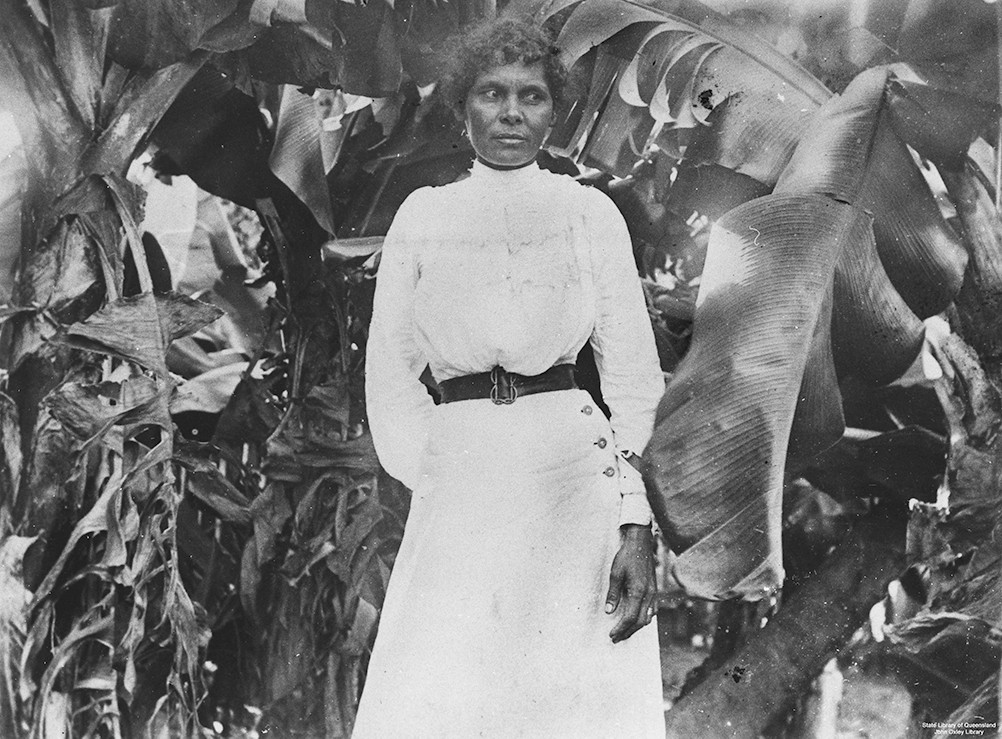
South Sea Islander woman at Farnborough, Queensland, ca. 1895, Negative number 3680, John Oxley Library, State Library of Queensland.
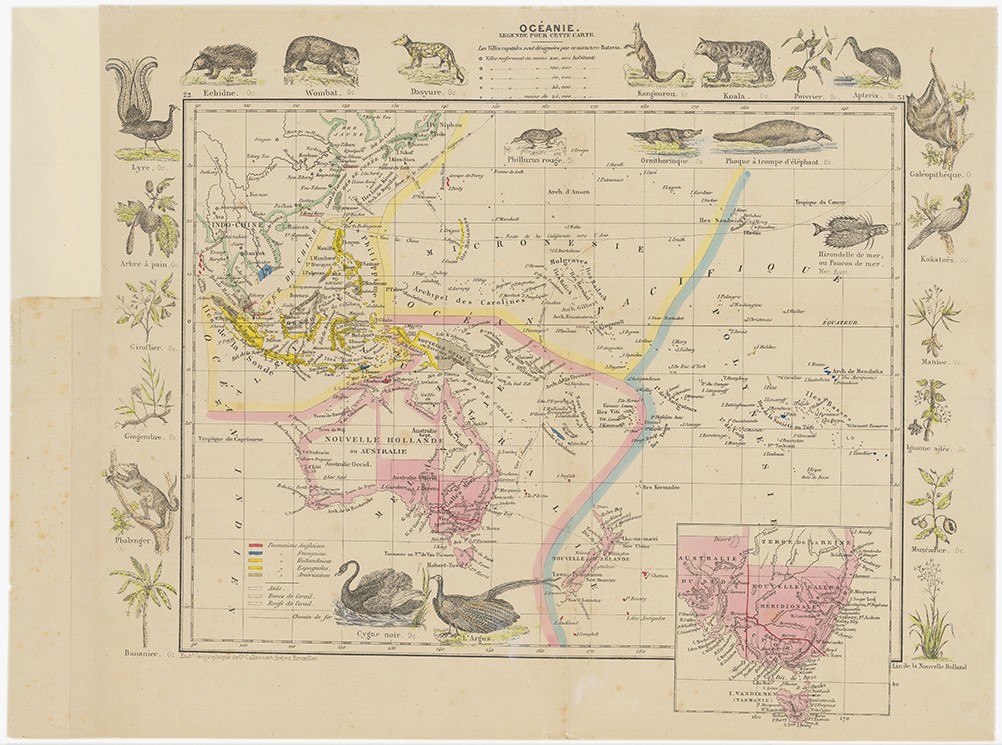
Oceanie. Bruxelles : Callewaert freres :1869, Record No. 725434, John Oxley Library, State Library of Queensland.
The Written Truth
Heritage maps from the John Oxley Library show the world as it was depicted in the early 1860s through the early 1900s when South Sea Islanders arrived by vessel from nearby islands to work as indentured labourers in Queensland. Over time the maps change, the spelling of names, the addition of islands and more. Information about the practice of indentured labour can be realised today from the monographs written by missionaries at the time. These volatile missives extoled the virtues of missionary work in the Melanesian Islands while condemning the practice of indentured servitude in Queensland as “slave labour” to the world. Further historical truths are revealed with the passage of monumental government policies: the White Australia Act and the Pacific Islanders Labourers Act, both of 1901. A Royal Commission was formed in 1906 to provide an humane review about the ordered mandatory deportation of Islanders, following the 1901 acts that forbade Islanders to be employed in Queensland.
Australian South Sea Islanders Today
More than 1000 contemporary images donated by photographer Brian Rogers to the State Library of Queensland begins to document the people and places that make up the many Australian South Sea Islander communities along Queensland's coast.In 2000, an exhibition called Refined White was developed by the Australian Sugar Industry Museum in Mourilyan in north Queensland. During its development, a suite of contemporary black and white images was taken to complement a selection of historical images from the John Oxley Library. These images reflected the themes of Work, Family, Food, Religion, and Recreation. This collection of images is the first major contribution of Australian South Sea Islander life to the State Library’s collection since the early historical images dating back to 150 years ago.
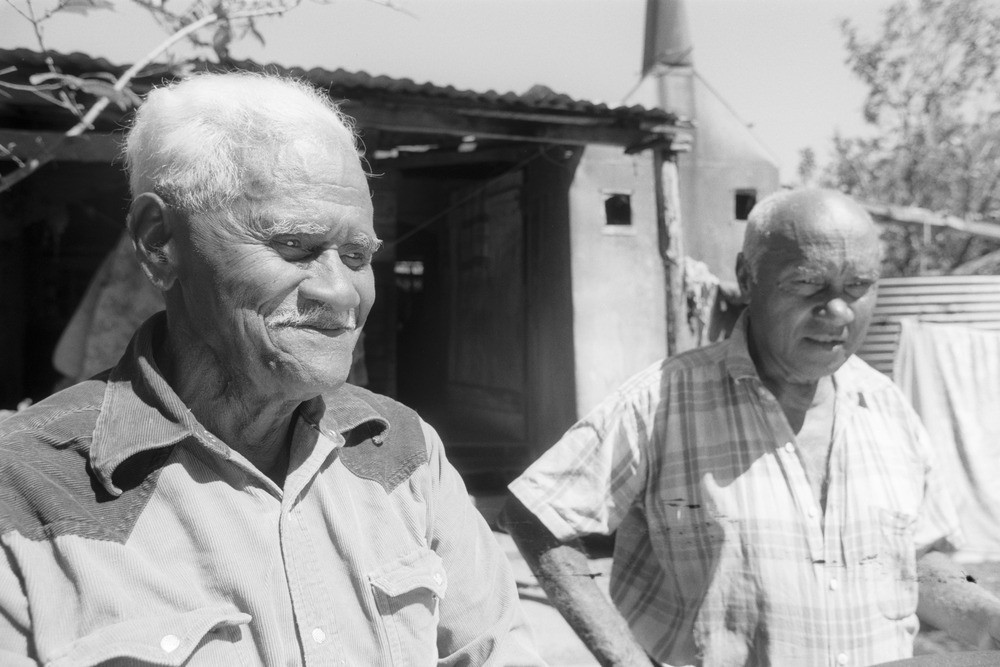
Percy and Roy Mooney outside their house in Habana near Mackay, Queensland, 2000, 28873 Refined White Exhibition 2001 Photographic Materials, Image number 28873-0001-0008, John Oxley Library, State Library of Queensland.
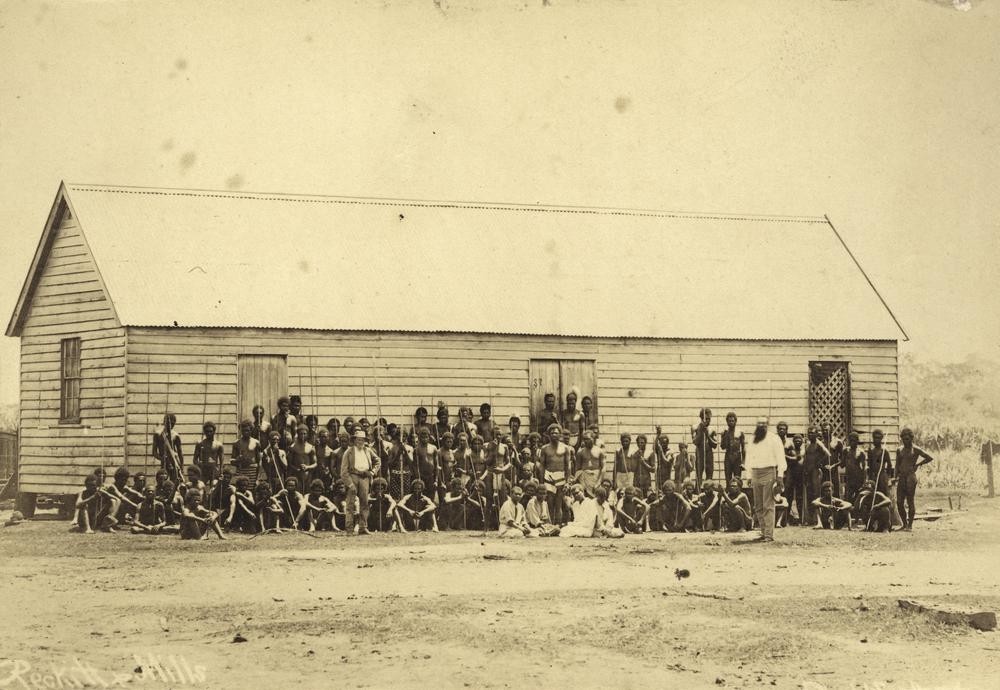
Australian South Sea Islanders photographed at Bingera Sugar Plantation, 6147 Trackson Family Photograph Albums, Image number APE-021-01-0006, John Oxley Library, State Library of Queensland.
Memories from A Forgotten People
Compelling conversations have been captured in emotional and powerful storytelling from the descendants of the first Australian South Sea Islanders at State Library of Queensland. who have come together to tell their stories about what the 150-year heritage anniversary means to them. Beginning in 1863, some 62,000 people were kidnapped or taken from South Sea Islands to work in the sugar and cotton industries in Queensland. By 1908, these same people faced compulsory “repatriation” to the islands under the White Australia Policy and the Pacific Island Labourers Act of 1901. Those remained often suffered harsh treatment and discrimination.
Plantation Voices
Plantation Voices is State Library’s portal to Australian South Sea Islander culture and history in Queensland. Over time State Library has cultivated resources and collections telling the story of Australian South Sea Islanders and celebrating their contributions to contemporary Queensland.
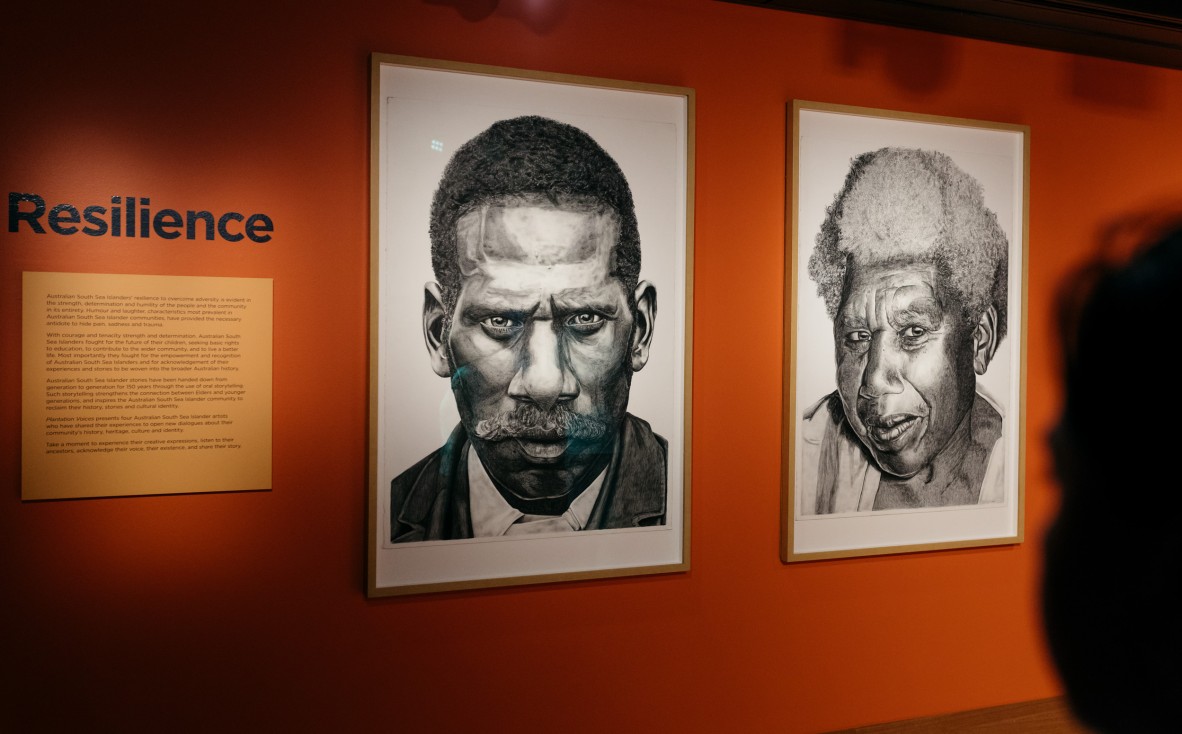
Plantation Voices Gallery featuring Dylan Mooney's 2 artworks from the Stop and Stare series.
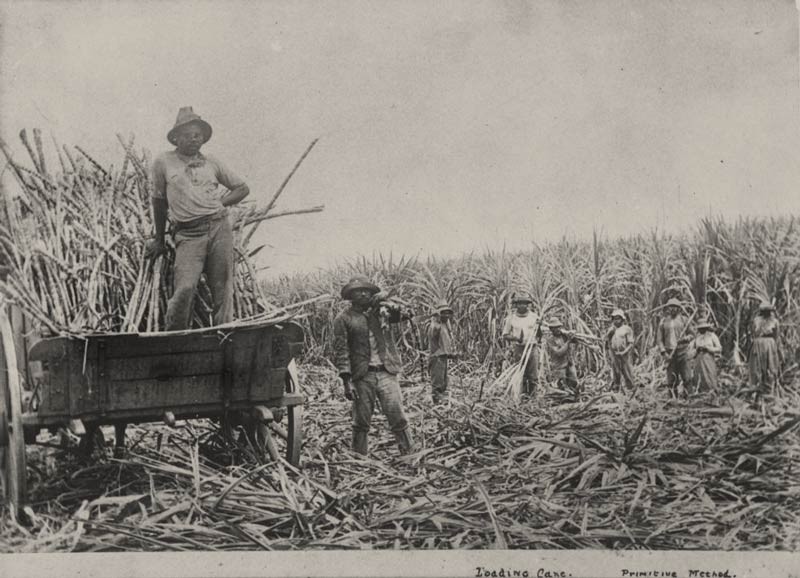
South Sea Islanders labourers loading cut sugar cane into a wagon, Queensland. Negative number 16964, John Oxley Library, State Library of Queensland.
Blog
Search for articles on Australian South Sea Islander heritage, culture and stories on the John Oxley Libray Blog.
Cindie : a chronicle of the canefields / Jean Devanny 1894-1962. London : Robert Hale : 1949
The cruise of the ’Rosario’ amongst the New Hebrides and Santa Cruz Islands, exposing the recent atrocities connected with the kidnapping of natives in the South Seas / by Albert Hastings Markham. London : Sampson Low, Martson, Low and Searle, 1873
History of kanakas in Bowen / Vanessa Marie Corowa ; Bowen Historical Society and Museum. 1991
Kanakas, kidnapping and slavery : myths from the nineteenth century labour trade and their relevance to Australian Melanesians. Clive Moore. 1981. Photocopy of article from ’Kabar Seberang: Sulating Maphilindo, No.8-9, 1981, p.78-92
Kanake : the Melanesian way / J.M. Tjibaou, Ph. Missotte ; photographs: M.Folco, C. Rives ; original French text translated by Christopher Plant, with the collaboration of the University of the South Papeete, Tahiti : Les editions du pacifique, c1978
Slavers of the South Seas / Thomas Dunbabin 1883- . Sydney : Angus & Robertson : 1935
South Sea Islanders came to Buderim / Hessie Lindsel; Buderim Historical Society. <Buderim, Qld.> : Buderim Historical Society Inc. : c1995
Sweet tea / Brian Ridden. South Melbourne : Lothian : 2002
This dawning land / Tony Matthews 1949- . Brisbane : Boolarong : 1986
Trinity phoenix : a history of Cairns and district / Dorothy Jones Archibald Meston 1851-1924; Cairns and District Centenary Committee. Cairns, Q. : Cairns and District Centenary Committee : 1976
Wacvie / <by> Faith Bandler. Adelaide ; Rigby, 1977
What I know of the labour traffic. Duffield, A. J. Brisbane : Watson, Ferguson & Co., 1884
Further correspondence relating to Polynesian labour in the Colony of Queensland Main Author: Great Britain. Colonial Office Publication: London : H.M.S.O., 1893
Further correspondence relating to the importation of South Sea Islanders into Queensland. Great Britain. Colonial Office. London : 1871
Imperial and colonial acts relating to the Pacific Island labour trade, and regulations and instructions for the guidance of Government agents appointed under the Pacific Island labourers act of 1880. Queensland.; Great Britain. Brisbane : Acting Government Printer : 1884
Report, together with minutes of evidence and proceedings of the commission and appendices. Queensland. Royal Commission on the Sugar Industry. ;William Henry Groom. Brisbane : Govt. Print :1889
A large number of photographs are held at State Library. Some of these are included in large personal collections of individuals, in the form of photograph albums or original photographs.
OH 39 Redland Shire Oral History. Redland (Qld.). Council. Abstract: A collection of 125 interviews regarding the history of the Redland shire. Box 9696. Item 107: Joyce May Krause - Transcript. Ms Joyce Krause's great grandfather, Hermann Holzapfel, was one of the first settlers on Mt Cotton in 1872, along with other German families who gravitated to the area. She speaks about evidence of Chinese settlement on the mountain and has documentation of Kanakas constructing the first church and school